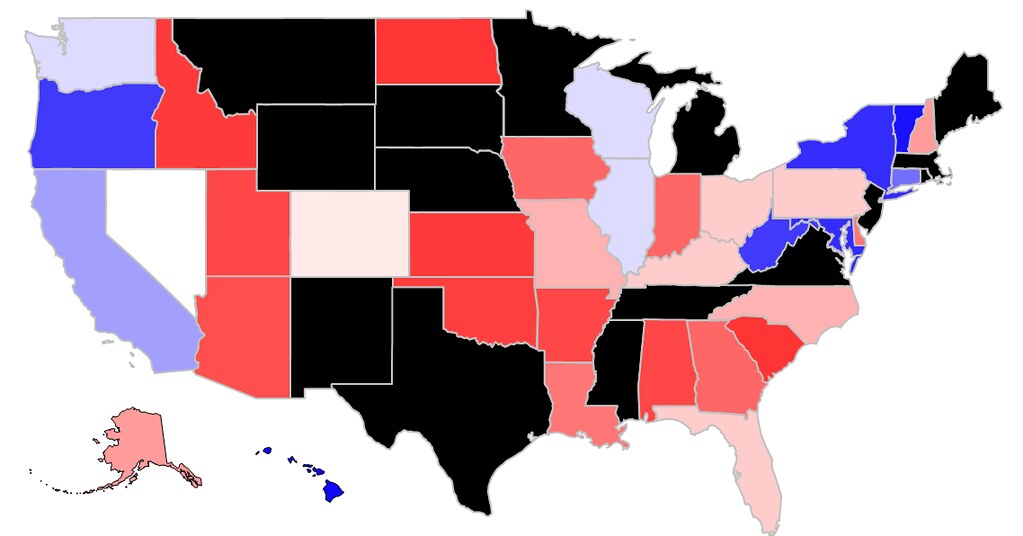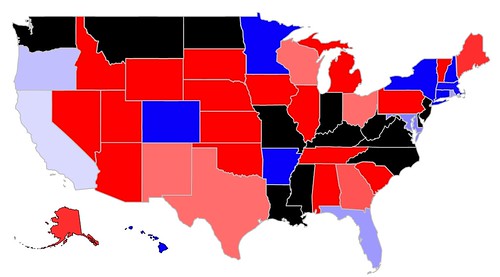At long last, I have finished making predictions, this time mixing my “gut feeling” predictions from earlier with the formula prediction methods I had used since 2006. I found the dearth of House polls very annoying, so many of my House predictions could be way off. We shall see in 12 or so hours.

Alabama: Bentley by 15.33%
Alaska: Parnell by 15.67%
Arizona: Brewer by 15%
Arkansas: Beebe by 25.67%
California: Brown by 14.33%
Colorado: Hickenlooper by 3.67%
Connecticut: Malloy by 5.67%
Florida: Sink by 1.67%
Georgia: Deal by 7.67%
Hawaii: Abercrombie by 5%
Idaho: Otter by 22%
Illinois: Brady by 4.67%
Iowa: Branstad by 10.5%
Kansas: Brownback by 27%
Maine: LePage by 11.33%
Maryland: O’Malley by 12.67%
Massachusetts: Patrick by 2.67%
Michigan: Snyder by 16.67%
Minnesota: Dayton by 1.33%
Nebraska: Heineman by 42%
Nevada: Sandoval by 15.67%
New Hampshire: Lynch by 8.33%
New Mexico: Martinez by 8.33%
New York: Cuomo by 22%
Ohio: Strickland by 1%
Oklahoma: Fallin by 18.5%
Oregon: Kitzhaber by 1.67%
Pennsylvania: Corbett by 9%
Rhode Island: Chafee by 8%
South Carolina: Haley by 8.33%
South Dakota: Daugaard by 13.67%
Tennessee: Haslam by 28%
Texas: Perry by 1%
Utah: Herbert by 25.33%
Vermont: Shumlin by 2%
Wisconsin: Walker by 8.67%
Wyoming: Mead by 36%
OVERALL: Republicans gain a net of 5 for the majority of governorships, 27-22-1

Alabama: Shelby by 28%
Alaska: McAdams by 0.67% (Miller in 2nd; Murkowski in 3rd)
Arizona: McCain by 23%
Arkansas: Boozman by 19.67%
California: Boxer by 6.67%
Colorado: Buck by 1%
Connecticut: Blumenthal by 8%
Delaware: Coons by 14%
Florida: Rubio by 16%
Georgia: Isakson by 25.67%
Hawaii: Inouye by 24.5%
Idaho: Crapo by 44%
Illinois: Kirk by 4.33%
Indiana: Coats by 10.33%
Iowa: Grassley by 31%
Kansas: Moran by 40%
Kentucky: Paul by 3.18%
Louisiana: Vitter by 5.87%
Maryland: Mikulski by 26.67%
Missouri: Robin Carnahan by 0.67%
Nevada: Reid by 0.67%
New Hampshire: Ayotte by 15%
New York A: Schumer by 28.67%
New York B: Gillibrand by 18.33%
North Carolina: Burr by 12.33%
North Dakota: Hoeven by 47%
Ohio: Portman by 9.83%
Oklahoma: Coburn by 40%
Oregon: Wyden by 15.33%
Pennsylvania: Toomey by 4.67%
South Carolina: DeMint by 42% (The Green candidate may get more votes than the Greene candidate.)
South Dakota: Thune by 70-90%
Utah: Lee by 25.33%
Vermont: Leahy by 35%
Washington: Murray by 1.88%
West Virginia: Manchin by 1.33%
Wisconsin: Johnson by 7.67%
OVERALL: Republicans gain a net of 5, but Democrats retain control 54-46
Light Blue = D+1; Light Red = R+1; Red = R+2; Medium-Dark Red = R+3; Dark Red = R+4; Very Dark Red = R+5

AL-02: Bright by 3.75%
AZ-01: Gosar by 4% (R pickup)
AZ-03: Hulburd by 1.17% (D pickup)
AZ-05: Schweikert by 0.67% (R pickup)
AZ-07: Grijalva by 4.08%
AZ-08: Giffords by 6.12%
AR-01: Crawford by 5.56% (R pickup)
AR-02: Griffin by 11% (R pickup)
CA-03: Lungren by 3.75%
CA-11: McNerney by 2.75%
CA-18: Cardoza by 10.75%
CA-20: Costa by 2.87%
CA-44: Calvert by 13.17%
CA-45: Bono Mack by 15%
CA-47: Sanchez by 8.25%
CO-03: Salazar by 1.25%
CO-04: Gardner by 3.58% (R pickup)
CT-04: Himes by 2.42%
CT-05: Murphy by 4.17%
DE-AL: Carney by 9.83% (D pickup)
FL-02: Southerland by 9.25% (R pickup)
FL-08: Webster by 3.25% (R pickup)
FL-22: Klein by 0.94%
FL-24: Adams by 6.25% (R pickup)
FL-25: Rivera by 3%
GA-02: Bishop by 2.67%
GA-08: Scott by 12.5% (R pickup)
HI-01: Hanabusa by 2.17% (D pickup)
ID-01: Minnick by 2.42%
IL-10: Seals by 7.6% (D pickup)
IL-11: Kinzinger by 5.13% (R pickup)
IL-14: Hultgren by 0.31% (R pickup)
IL-17: Schilling by 2.63% (R pickup)
IN-02: Donnelly by 4.38%
IN-08: Buschon by 8.75% (R pickup)
IN-09: Hill by 0.52%
IA-01: Braley by 10%
IA-02: Loebsack by 8.75%
IA-03: Boswell by 8.07%
KS-03: Yoder by 10% (R pickup)
KY-03: Yarmuth by 10.5%
KY-06: Chandler by 3.69%
LA-02: Richmond by 11.83% (D pickup)
LA-03: Landry by 12.25% (R pickup)
ME-01: Pingree by 12.42%
MD-01: Harris by 4.92% (R pickup)
MA-10: Keating by 2.63%
MI-01: Benishek by 2.71% (R pickup)
MI-07: Schauer by 0.44%
MI-09: Peters by 3.88%
MN-01: Walz by 10.42%
MN-08: Oberstar by 4.88%
MS-01: Childers by 0.88%
MS-04: Taylor by 2.69%
MO-03: Russ Carnahan by 5.63%
NV-03: Titus by 0.33%
NH-01: Guinta by 10.25% (R pickup)
NH-02: Bass by 0.08% (R pickup)
NJ-03: Runyan by 1.13% (R pickup)
NM-01: Barela by 0.63% (R pickup)
NM-02: Pearce by 4.83% (R pickup)
NY-01: Bishop by 7.56%
NY-13: McMahon by 7.5%
NY-19: Hayworth by 1.02% (R pickup)
NY-20: Gibson by 3.46% (R pickup)
NY-23: Owens by 0.88%
NY-24: Arcuri by 3.31%
NY-25: Maffei by 6.58%
NY-29: Zeller by 12.5% (R pickup)
NC-02: Etheridge by 2.5%
NC-07: McIntyre by 3.75%
NC-08: Kissell by 2.38%
NC-11: Shuler by 11.88%
ND-AL: Berg by 4.97% (R pickup)
OH-01: Chabot by 6.25% (R pickup)
OH-06: Wilson by 2.06%
OH-13: Sutton by 10%
OH-15: Stivers by 6.25% (R pickup)
OH-16: Renacci by 0.63% (R pickup)
OH-18: Gibbs by 1.88% (R pickup)
OR-05: Schrader by 2.75%
PA-03: Kelly by 6.25% (R pickup)
PA-04: Altmire by 12.58%
PA-07: Meehan by 3.83% (R pickup)
PA-08: Fitzpatrick by 4.53% (R pickup)
PA-10: Marino by 4.57% (R pickup)
PA-11: Barletta by 2.13% (R pickup)
PA-12: Critz by 5.38%
PA-15: Dent by 11.63%
RI-01: Cicilline by 4.94%
SC-05: Mulvaney by 4.75% (R pickup)
SD-AL: Noem by 0.31% (R pickup)
TN-04: DesJarlais by 1% (R pickup)
TN-06: Black by 12.5% (R pickup)
TN-08: Fincher by 9.5% (R pickup)
TX-17: Edwards by 1.72%
TX-23: Rodriguez by 2.15%
TX-27: Ortiz by 2.88%
VA-02: Rigell by 3.04% (R pickup)
VA-05: Hurt by 5.28% (R pickup)
VA-09: Boucher by 4.5%
WA-02: Larsen by 5.75%
WA-03: Herrera by 3.56% (R pickup)
WA-08: Reichert by 5.38%
WV-01: McKinley by 2.25% (R pickup)
WI-03: Kind by 8.75%
WI-07: Duffy by 7.21% (R pickup)
WI-08: Ribble by 5.46% (R pickup)
OVERALL: Republicans gain a net of 42 for control 220-215






